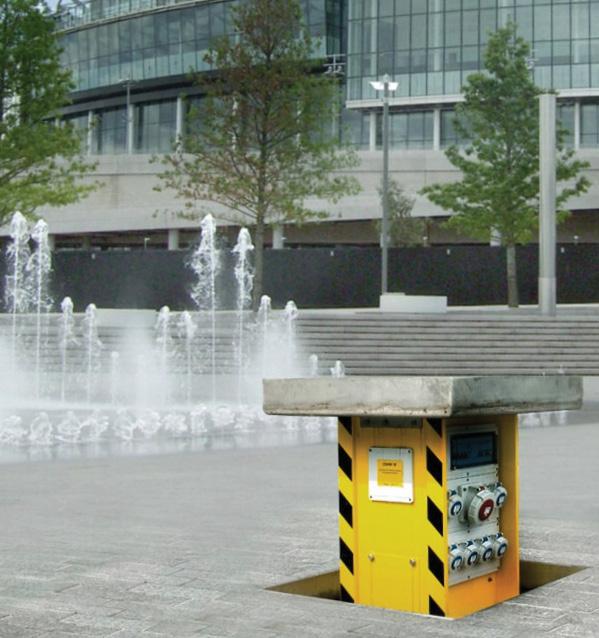
8 minute read
VIEWPOINT
How To Specify Outdoor Power Distribution Units To Meet Anticipated Demand
Adding a power supply infrastructure to an outdoor public space, such as a courtyard or enclosed garden, is an excellent way to unlock the potential for holding events and creating more revenue-generating space. But how can you ensure that the proposed power supply will meet the demands and needs of the site given the versatility that comes when an outdoor space is power-connected?
Advertisement
Over-specifying the services infrastructure and distribution units could be a costly mistake. But under-specifying could result in the need to hire temporary generators or run lengthy trailing cables from adjacent buildings, creating avoidable trip hazards.
Whether you are a site owner or an architect or landscape architect working to enhance an outdoor space, the starting point is to ask three basic questions about demand and needs: 1) How do you envisage that your proposed power unit or power distribution system will be used? 2) How many power sockets will be needed? 3) Would the location also benefit from a supply of water or data connectivity?
Designing-in versatility - Equipping any outdoor space with a power infrastructure is going to add a great degree of flexibility of use to the location. But when designing the power supply, it is important to have a picture of the typical and maximum usage that will be required.
Going back to basics, why is the site going to benefit from a power infrastructure? For a business such as a restaurant, bar, café or hotel, the outdoor space could add additional areas for eating and drinking primarily. Such uses would typically require the power distribution to provide access to sockets for lighting, till points, AV equipment or outdoor serving
points such as mobile counters or drinks dispensers. But is that the limit to such a site’s potential? Could it also be used as a stage are for outdoor music performances and other entertainment, for example. And if so, would your proposed power supply solution accommodate these requirements too? Also think about the location of the power units in relation to how they will be used.
If the site is to be used for market stalls, where will the stalls be set up on site and where will the main pedestrian routes be? Installing power units in the correct locations will help reduce the risk of trip hazards as cables trailing across the main footfall areas can be minimised or avoided completely.
Once you have a picture of how the site could be used, it is time to consider how you feed power to the locations across the space. This can be achieved with the installation of a Pop Up Power Supplies® power distribution unit in one of three forms: 1) Pop up, retractable power unit – this is submerged in the group until it is needed, and raised/lowered using a turning handle. 2) Flip-lid, in ground power unit – this is permanently submerged in the ground with access provided via a flip-lid which can be used while the lid is locked down. 3) Power bollard – a street furniture element which has power sockets integrated, accessible as required behind a lockable cover. The type of power unit you choose will depend on how the site will need to look or be used when the space is not being used for events, catering, etc. Both the pop-up and in-ground units can be hidden away when they are not in use, with the only evidence being a cover which can be designed to match surrounding surface materials.
A power bollard has a permanent presence, but the designs available from Pop Up Power Supplies® are elegant to avoid the utilitarian appearance that would be expected with a typical feeder pillar.
What should each power unit provide? - Consider what the electricity demand will be for the equipment that is to be connected to ensure the power supply units can handle the load. This is an area where Pop Up Power Supplies® has a wealth of expertise to help, given our experience of providing power units for a diverse range of sites across the UK, from Caerphilly Castle visitor centre to Chelsea FC’s Stamford Bridge pitch.
The retractable power units available from Pop Up Power Supplies® can be specified to provide a total power supply from as little as 63 amps right up to 600 amps. In ground units offer the option of 63 amps or 125 amps and power bollards provide up to 125 amps. The sockets in all can be configured to suit usage requirements.
These units can also be designed to provide a water supply or data connectivity. Access to water can be particularly useful for ground maintenance and cleaning purposes, so consider that too and the units can become extremely useful assets. www.popuppower.co.uk


Building Safety Act Signals Critical Period Of Planning For Construction Industry
Marc van der Voort, Managing Director at ITP Ltd, examines the challenges facing the construction supply chain in preparing for a new regulatory landscape under the Building Safety Act. The Government’s Building Safety Bill as received Royal Assent in April, completing all the parliamentary stages in both Houses to become an Act of Parliament. The Building Safety Act includes a range of measures which, according to the government, are expected to take 12- 18 months to introduce.
For the construction industry, that period will be critical in assessing the implications and planning accordingly. The Building Safety Act will give residents more power to hold builders and developers to account and toughen sanctions against those who compromise safety.
A new Building Safety Regulator will be at the heart of the reforms, overseeing the “safety and performance of all buildings” and implementing the new, more stringent regulatory regime for higher-risk buildings. The regulator will also assist and encourage competence among the built environment industry, and registered building inspectors.

Stricter oversight is likely to have an effect throughout the construction supply chain. The government has stated that it “will place legal responsibilities on those who commission building work, participate in the design and construction process and those who are responsible for managing structural and fire safety in higher-risk buildings when they are occupied. These people will be called dutyholders during design and construction, and Accountable Persons when the building is occupied.” Many organisations and individuals in the construction and property sectors will be wary of finding themselves charged with an unwitting failure to meet those responsibilities when the legislation comes into effect.
Prior to Grenfell, developers across the UK installed ACM cladding on the basis that it met regulations. Without knowledge or understanding of the increased risk of using that material, they made their decision according to the standards set out in law at the time. Those developers are now paying the cost of rectifying their decision in line with a subsequent change in laws. With regulations set to be further tightened and more robustly enforced as part of the Building Safety Act, many developers will now be mindful that decisions they make in 2022 could be subject to remediation in the years ahead as the new regulatory landscape takes shape. In the past five years, the pace of change has already exposed regulatory inconsistencies which are ripe for further scrutiny.
Advances in construction technology have made some regulations appear outdated – notably in relation to the design of external walls, the area of risk which was central to Grenfell. Current law requires breather membranes and vapour control layers to have a minimum Euroclass B fire safety rating compared to a Euroclass A rating required for other wall elements such as cladding. The legislation was drafted in the year that followed Grenfell, when the textile technology had not developed to the extent that they could provide a Euroclass A rating while still performing vital functions such as breathability and waterproofing to an adequate level.
As a result, breather membranes and vapour control layers were made exempt from Euroclass A. The legislation came into effect in December 2018. Since then, advances in product development have led to the emergence of breather membranes and vapour control layers which are Euroclass A rated without compromising the other key attributes. Therefore, there is no reason not to apply the same levels of fire safety throughout the external envelope and remove the exemption which applies to these elements. The complicated and changeable nature of fire safety regulation is a huge challenge for developers, building owners, facilities managers and specifiers.
To deliver a reliable and robust fire safety concept, it is vital that these parties have an understanding of how design and manufacture will affect performance once installed. To enable that understanding, they need the whole supply chain to be open and transparent. However, relying on good faith is not a failsafe solution: more robust frameworks should be introduced for the procurement of building products, ensuring that every decision is made with knowledge of best practice, the relevant certification and the best available options to optimise long-term fire protection.
The same knowledge is essential for installers to ensure that the necessary competencies are met at every step. Such measures will take time to complete. In the meantime, we have a collective responsibility to promote and encourage awareness, understanding and culture change across the sector. There are no shortcuts on the roadmap to fire safety - navigating its complexities requires rigorous attention to detail. Every decision made in the supply chain should be driven by that principle. www.itpltd.com







